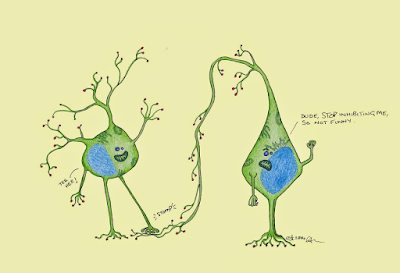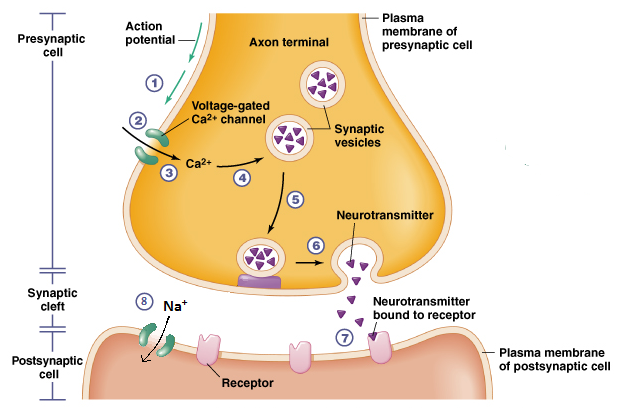
Synapse
- point where 2 neurones meet but do not touch- contains the end of presynaptic neurone + synaptic cleft + end of postsynaptic neurone
Mechanism of synaptic transmission
1. action potential
arrives at presynaptic neurone
2. stimulates opening of
voltage-gated channels for Ca2+
3. Ca2+
diffuse into cytoplasm of presynaptic membrane
4+5. Ca2+
cause vesicles containing acetylcholine (ACh – a type of neurotransmitter) move
towards the presynaptic membrane
6. Vesicle fuses with
the membrane, Ach is released and diffuses across the synaptic cleft
7. Ach temporarily binds
to receptor proteins on the postsynaptic membrane; causes chemically-gated ion
channels for Na+ to open
8. Na+
diffuse through postsynaptic membrane àdepolarizes membrane à generates action potential
9. Recycling of Ach,
catalysed by acetylcholinsterase (stops continuous production of action potentials)
10. choline moves back
into the presynaptic neurone
ACh transported back to
presynaptic vesicles
 Functions of synapses
Functions of synapses
1. ensures one-way
transmission: neurotransmitters are only released on one side of synapse;
receptors on the other side of synapse
2. integration of
impulses: the body of motor neurones are covered with terminations of multiple
relay neurones. The motor neurone only transmits impulses and initiate action
potentials if the threshold potential is reached. This ensures that the brain
is not overloaded with sensory information.
3. allow connection of
nerve pathways: axons branch out to form more synapses with multiple neurones à humans have a wider range
of behaviours
- in dangerous situations: information from 1 neurone spreads throughout the body to reach many relay neurones and effectors
- decision-making in brain: motor neurones have many dendrites à larger surface area for a lot of synapses à neurone can integrate information from many parts of the body
4. involved in memory making and learning: e.g.: brain receives information about 2 things at the same time à new synapses form
The nervous system provides fast communication between receptors and effectors. Transmission between neurones takes place at synapses. a) compare the nervous and endocrine systems as communication systems that co-ordinate responses to changes in the internal and external environment b) describe the structure of a sensory neurone and a motor neurone c) outline the roles of sensory receptor cells in detecting stimuli and stimulating the transmission of nerve impulses in sensory neurones (a suitable example is the chemoreceptor cell found in human taste buds) d) describe the functions of sensory, relay and motor neurones in a reflex arc e) describe and explain the transmission of an action potential in a myelinated neurone and its initiation from a resting potential (the importance of sodium and potassium ions in impulse transmission should be emphasised) f) explain the importance of the myelin sheath (saltatory conduction) in determining the speed of nerve impulses and the refractory period in determining their frequency g) describe the structure of a cholinergic synapse and explain how it functions, including the role of calcium ions h) outline the roles of synapses in the nervous system in allowing transmission in one direction and in allowing connections between one neurone and many others (summation, facilitation and inhibitory synapses are not required) i) describe the roles of neuromuscular junctions, transverse system tubules and sarcoplasmic reticulum in stimulating contraction in striated muscle j) describe the ultrastructure of striated muscle with particular reference to sarcomere structure k) explain the sliding filament model of muscular contraction including the roles of troponin, tropomyosin, calcium ions and ATP. l) explain the roles of the hormones FSH, LH, oestrogen and progesterone in controlling changes in the ovary and uterus during the human menstrual cycle m) outline the biological basis of contraceptive pills containing oestrogen and/or progesterone |



good notes
ReplyDeletethey are detailed notes
ReplyDelete